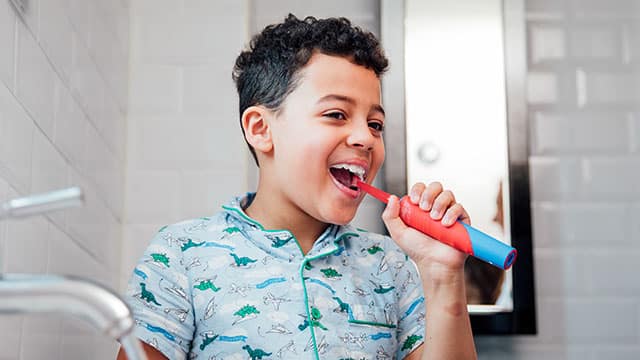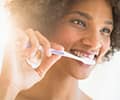What Is an Electric Toothbrush?
Usually powered by a battery, electric toothbrushes use oscillating movements to clean. They're an excellent oral care tool. And with a parent's guidance, they may help remove plaque bacteria (biofilm) and food along the gumline. Some people enjoy electric toothbrushes because they feel they clean their teeth better than a manual toothbrush, and they may be easier to use too! Like a manual toothbrush, an electronic one has a base for gripping and ahead with bristles. As you would replace a manual toothbrush every few months, you'll want to replace the head of your electric toothbrush when you see the bristles are worn. You can change the head every three months.
Benefits of Using an Electronic Toothbrush for Kids
Using an electric toothbrush has many advantages. A Cochrane Library review found significant benefits of using an electric toothbrush. The review found a larger reduction in plaque and gingivitis by those who used an electric toothbrush compared to those who used a manual one.
Besides these positive findings, there are other reasons an electric toothbrush may be a great fit for your child. They might gain more confidence in their oral health routine with an electric brush because it could be more comfortable to hold, easier to position on the teeth and gumline and brush the teeth' biting surfaces more efficiently. If you are unsure which brush is best for your child, discuss it with your dental professional at your next dental exam and professional cleaning appointment.
In addition to keeping your child's teeth clean, electric toothbrushes for kids have some fun perks. Many powered brushes come in various character-themed styles, with different colors and light-up features, which can entice children to practice good oral health care.
How to Pick the Right Electric Toothbrush for Kids
As with a standard brush, it's essential to select your child's right size and style. Be sure to choose an electric toothbrush with a child-sized head so that it fits properly in your child's mouth and can reach all the way to the back teeth comfortably. For younger children and toddlers, be sure to select soft bristles, which are gentler on gums, and recommended if your little one is still cutting new teeth.
Did you know that the first electric toothbrush was introduced in 1954? While this fun fact may not get your kid excited, we're sure that a chance for them to choose their own toothbrush will! For children who are reluctant brushers, picking their own brush will empower them in the process. You may even want to keep more than one brush available at home so they can decide between them each brushing session.
Proper Technique Is Key
Remember that an electric toothbrush cannot do all the work on its own. You will still need to help your child practice proper brushing techniques to prevent cavities. Show your child how to place the brush at a 45-degree angle toward the gumline. Even with the powered brush movement, your child will still need to move it back and forth against the teeth and gums using short, gentle strokes. Rinse your child's brush well after each use, and store it upright. Replace your child's toothbrush every three months. After a cold, flu, or other infection, throw that toothbrush out immediately. You probably need to replace your child's toothbrush more often than your own, especially if your child tends to chew on it.
We hope you feel inspired and excited to help your child begin or try a new approach to brushing their teeth. Rather than wondering, "are electric toothbrushes good for children's teeth?" you can concern yourself with the more fun parts of oral health care. It's time to help your child pick out a toothbrush, teach them how to use it, and empower them to continue this routine as they grow!
This article is intended to promote understanding of and knowledge about general oral health topics. It is not intended to be a substitute for professional advice, diagnosis or treatment. Always seek the advice of your dentist or other qualified healthcare provider with any questions you may have regarding a medical condition or treatment.
ORAL HEALTH QUIZ
What's behind your smile?
Take our Oral Health assessment to get the most from your oral care routine
ORAL HEALTH QUIZ
What's behind your smile?
Take our Oral Health assessment to get the most from your oral care routine
Join Us
Get the best of your oral health routine and take it to the next level with expert advice, recommendations, products and solutions and special offers.
Join Us
Get the best of your oral health routine and take it to the next level with expert advice, recommendations, products and solutions and special offers.












.png)


